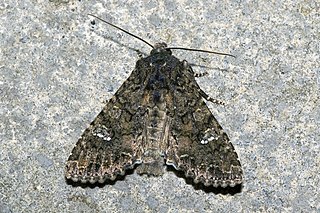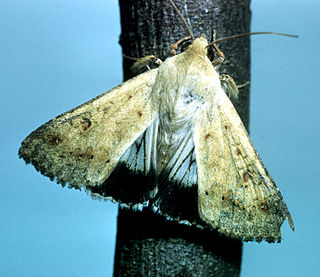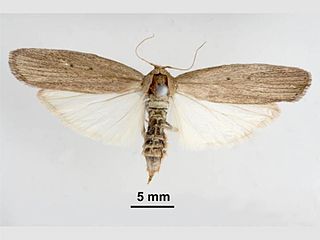
The Gelechiidae are a family of moths commonly referred to as twirler moths or gelechiid moths. They are the namesake family of the huge and little-studied superfamily Gelechioidea, and the family's taxonomy has been subject to considerable dispute. These are generally very small moths with narrow, fringed wings. The larvae of most species feed internally on various parts of their host plants, sometimes causing galls. Douglas-fir (Pseudotsuga) is a host plant common to many species of the family, particularly of the genus Chionodes, which as a result is more diverse in North America than usual for Gelechioidea.

Pieris brassicae, the large white, also called cabbage butterfly, cabbage white, cabbage moth (erroneously), or in India the large cabbage white, is a butterfly in the family Pieridae. It is a close relative of the small white, Pieris rapae.

The cabbage moth is primarily known as a pest that is responsible for severe crop damage of a wide variety of plant species. The common name, cabbage moth, is a misnomer as the species feeds on many fruits, vegetables, and crops in the genus Brassica. Other notable host plants include tobacco, sunflower, and tomato, making this pest species particularly economically damaging.

Manduca quinquemaculata, the five-spotted hawkmoth, is a brown and gray hawk moth of the family Sphingidae. The caterpillar, often referred to as the tomato hornworm, can be a major pest in gardens; they get their name from a dark projection on their posterior end and their use of tomatoes as host plants. Tomato hornworms are closely related to the tobacco hornworm Manduca sexta. This confusion arises because caterpillars of both species have similar morphologies and feed on the foliage of various plants from the family Solanaceae, so either species can be found on tobacco or tomato leaves. Because of this, the plant on which the caterpillar is found does not indicate its species.

The almond moth or tropical warehouse moth is a small, stored-product pest. Almond moths infest flour, bran, oats, and other grains, as well as dried fruits. It belongs to the family of snout moths (Pyralidae), and more specifically to the tribe Phycitini of the huge snout moth subfamily Phycitinae. This species may be confused with the related Indian mealmoth or the Mediterranean flour moth, which are also common pantry pests in the same subfamily.

The diamondback moth, sometimes called the cabbage moth, is a moth species of the family Plutellidae and genus Plutella. The small, grayish-brown moth sometimes has a cream-colored band that forms a diamond along its back. The species may have originated in Europe, South Africa, or the Mediterranean region, but it has now spread worldwide.

The Mediterranean flour moth or mill moth is a moth of the family Pyralidae. It is a common pest of cereal grains, especially flour. This moth is found throughout the world, especially in countries with temperate climates. It prefers warm temperatures for more rapid development, but it can survive a wide range of temperatures.

The leek moth or onion leaf miner is a species of moth of family Acrolepiidae and the genus Acrolepiopsis. The species is native to Europe and Siberia, but is also found in North America, where it is an invasive species. While it was initially recorded in Hawaii, this was actually a misidentification of Acrolepiopsis sapporensis.

The hornet moth or hornet clearwing is a large moth native to Europe and the Middle East and has been introduced to North America. Its protective coloration is an example of Batesian mimicry, as its similarity to a hornet makes it unappealing to predators. The hornet moth has been linked to the large dieback of poplar trees across Europe because its larvae bore into the trunk of the tree before re-emerging as adults.

Phthorimaea is a genus of moths in the family Gelechiidae. Species include the potato tuber moth, Phthorimaea operculella.

Pyralis farinalis, the meal moth, is a cosmopolitan moth of the family Pyralidae. Its larvae (caterpillars) are pests of certain stored foods, namely milled plant products.

Helicoverpa punctigera, the native budworm, Australian bollworm or Chloridea marmada, is a species of moth in the family Noctuidae. This species is native to Australia. H. punctigera are capable of long-distance migration from their inland Australian habitat towards coastal regions and are an occasional migrant to New Zealand.
Rhagoletis juglandis, also known as the walnut husk fly, is a species of tephritid or fruit fly in the family Tephritidae. It is closely related to the walnut husk maggot Rhagoletis suavis. This species of fly belongs to the R. suavis group, which has a natural history consistent with allopatric speciation. The flies belonging to this group are morphologically distinguishable.

Helicoverpa assulta, the oriental tobacco budworm, is a moth of the family Noctuidae. H. assulta adults are migratory and are found all over the Old World Tropics including Asia, Africa, and Australia.
Pollanisus nielseni is a moth of the family Zygaenidae. It inhabits the Australian state of Western Australia, mostly coastal areas, and has brilliantly shiny forewings. The diurnal adults are most active on sunny days. Eggs are laid on the plant Hibbertia spicata, and females touch each egg after oviposition with a tuft of hair on their abdomen, which attaches protective spines. The larvae are brightly coloured and feed on H. spicata before pupation.

Cadra figulilella, the raisin moth, is a moth of the family Pyralidae. The raisin moth is known most commonly as a pest that feeds on dried fruits, such as the raisin and date. It covers a range that includes much of the world, primarily situating itself in areas of California, Florida, the Eastern Mediterranean region, and some parts of Africa, Australia, and South America. The moth prefers to live in a hot, arid climate with little moisture and plentiful harvest for its larvae to feed on. Study of this species is important due to the vast amount of economic damage it causes yearly and worldwide to agriculture crops.

Trigonospila brevifacies is a species of true fly in the family Tachinidae native to eastern Australia. This species is also found in New Zealand. Like the vast majority of tachinid flies, T. brevifacies is a parasitoid of other insects, specifically late larval stages of a number of species of Lepidoptera. It is also known as the Australian Leaf-Roller Fly or Leafroller Fly.

Eldana is a genus of moths of the family Pyralidae containing only one species, the African sugar-cane borer, which is commonly found in Equatorial Guinea, Ghana, Mozambique, Sierra Leone and South Africa. Adults have pale brown forewings with two small spots in the centre and light brown hindwings, and they have a wingspan of 35mm. This species is particularly relevant to humans because the larvae are a pest of the Saccharum species as well as several grain crops such as sorghum and maize. Other recorded host plants are cassava, rice and Cyperus species. When attacking these crops, E. saccharina bores into the stems of their host plant, causing severe damage to the crop. This behavior is the origin of the E. saccharrina's common name, the African sugar-cane borer. The African sugar-cane borer is a resilient pest, as it can survive crop burnings. Other methods such as intercropping and parasitic wasps have been employed to prevent further damage to crops.
Liriomyza trifolii, known generally as the American serpentine leafminer or celery leafminer, is a species of leaf miner fly in the family Agromyzidae.

Copidosoma koehleri belongs to the family Encyrtidae and genus Copidosoma within the order Hymenoptera. It is a parasitoid and its hosts are mainly potato tuber moth but it also infest Andean potato tuber moth, Guatemalan potato tuber moth and Tomato leafminer. Super-parasitism is associated with C. koehleri.



















